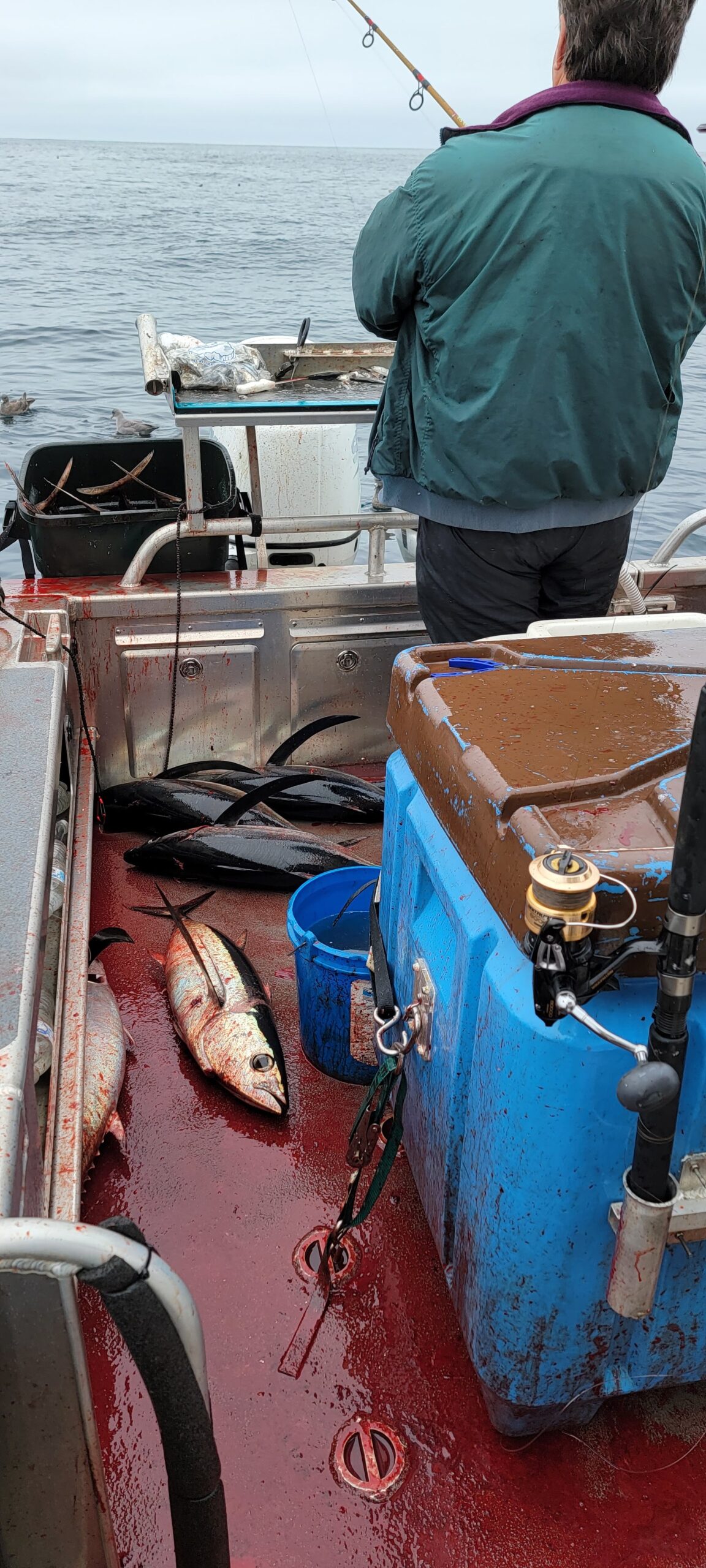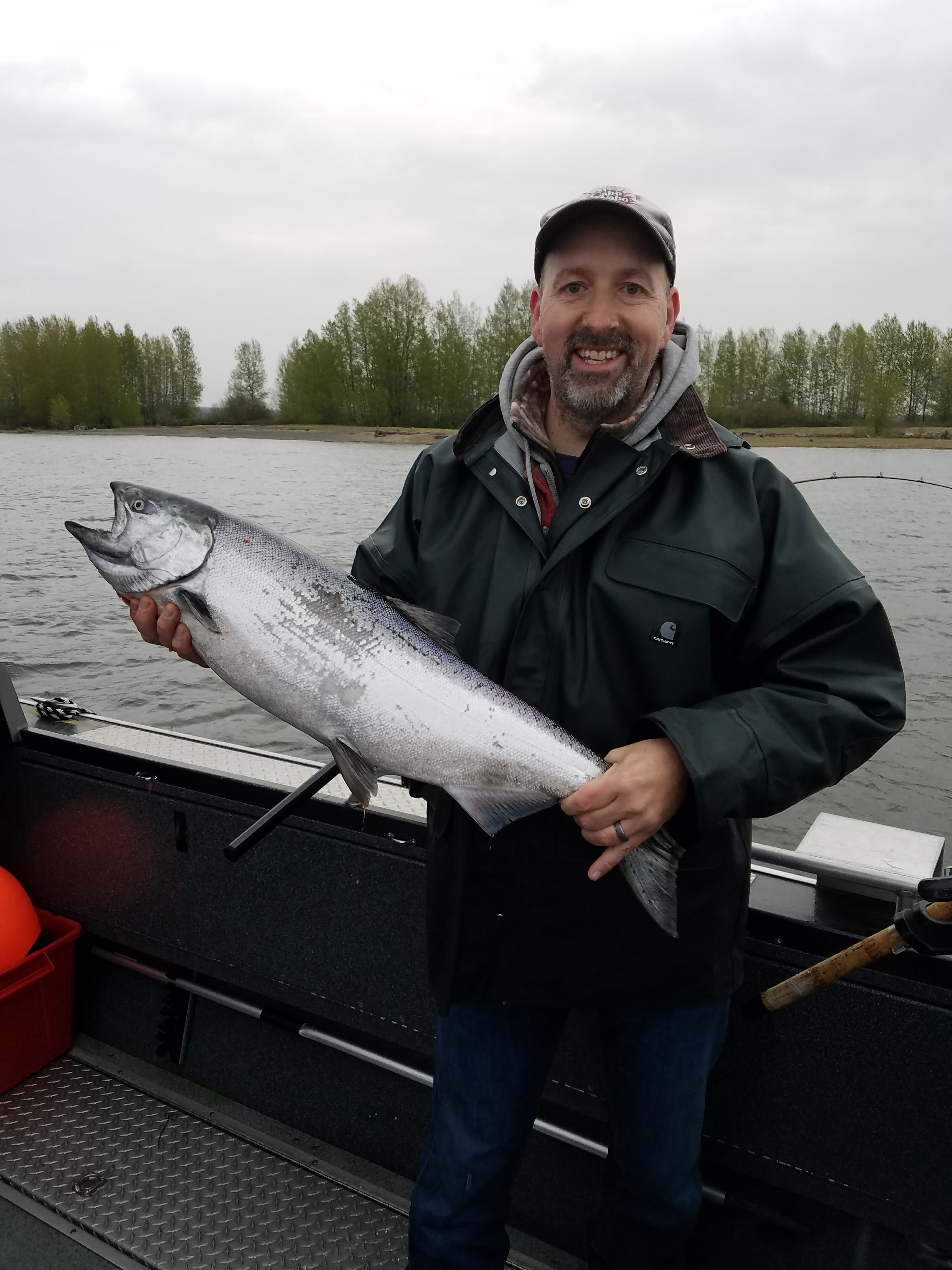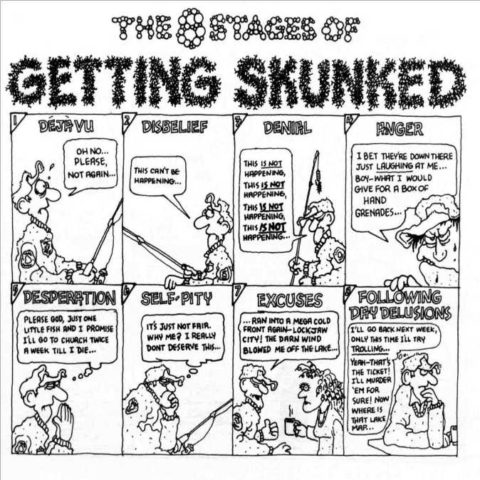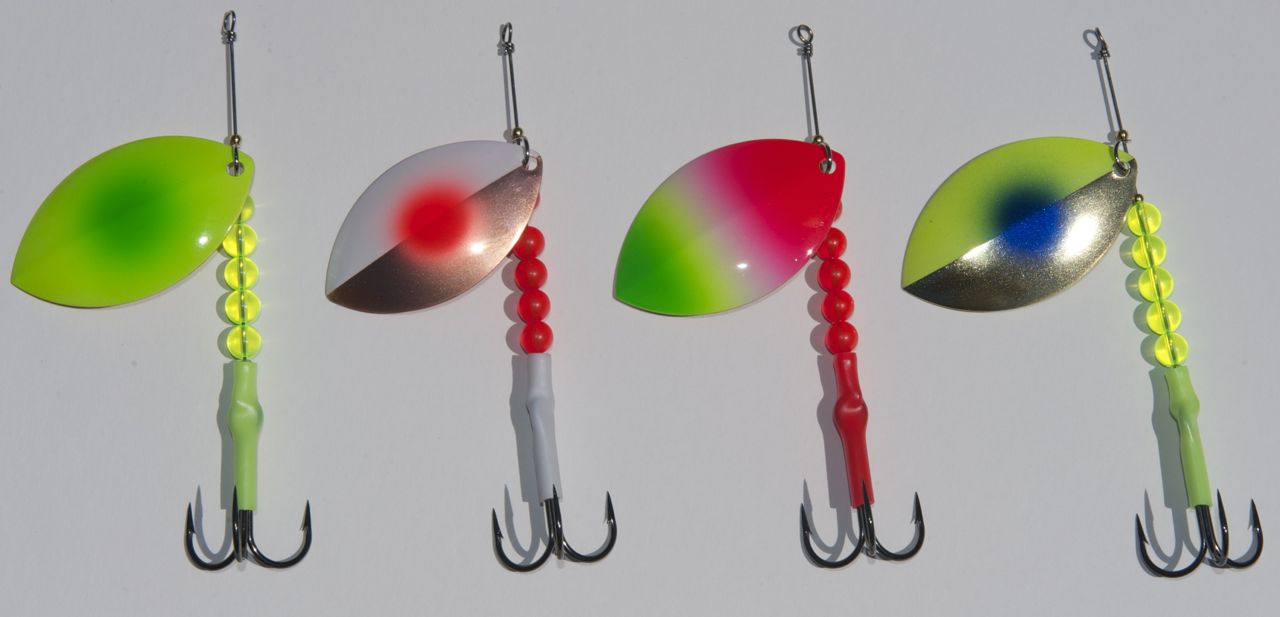
The makings of a spectacular tuna trip. Unbelievable!
I have not been fishing much this year due to other activities and priorities like starting a lavender farm and my oldest daughter getting married. Now that the dust has settled, I am getting some good opportunities to get out and kill some fish.
This particular opportunity, I was invited out on a friends boat for a late season tuna trip. We could not have asked for better water and weather conditions for early October. There was a fog forecast that kept many sitting on their couches. This was very fortunate for us.
We all gathered in Ilwaco, WA for an early launch. We had to wait for the bait dock to open. With the live bait comfy in the tank, we headed out. The seas were relatively calm and there was a light fog. Visibility looked to be about 3-4 miles. We headed west to about the 30 line where we started our troll.
It was not long before we got our first screamer. Tried to get a second on, but no luck. Tossed a few handfuls of chum in the water and started our live bait action. Tuna started jumping around us and the show was on. This action lasted about an hour or so. About twelve on the deck before it shut off. We did a little cleanup and processed the fish while getting back on the troll. Minutes later, we found the school again. This time, live bait, iron, it did not matter. Whatever we threw at them, fish on. Again, this lasted about an hour or so before it turned off. This time, fifteen or so on the deck. Rinse and repeat, a little cleanup and processing while on the troll for a few minutes before the next hookup and frenzy.
Because this boat has a self bailing deck, we tried to keep as much blood off the deck, but it was so crazy at times, there was no way to prevent it. Eventually, the sharks came. We had what looked like to be about a 10 ft blue shark started circling us. He stayed with us the rest of the day. It made for some interesting times bringing in the tuna.

We had one stop one of our crew was magic with the iron. We started calling him ‘Ironman’. There was a school about 50 ft off the bow and they would not come to us. Ironman would toss over some iron and within a twitch or two, he had fish on. He would hand off the rod and grab another to toss a jig over. Seconds again and fish on. We repeated this process for quite some time. My arms were getting so tired, I had to take a break and man the gaff. Before 1pm, we had as much as we could hold on the boat and had to stop. It is a sad day you have to leave jumpers.
We heard others on the radio to the south of us that seemed to be struggling. We happened to be in the right spot at the right time. The ocean was flat that made it easier to spot the jumpers and the fog never showed up. I feel very fortunate to have experienced what tuna fishing is supposed to be like.
On the ride back in, we hit a shark and had to remove it from the prop. The entire day, there were young sunfish in large schools jumping tricking us to think they were tuna from afar. We even had a whale jump out of the water in front of us and we had to stop to make sure we did not hit it. It was an incredible day.


2018 Springer Fishing – Hail Mary
Springer season on the lower Columbia is officially closed, but the WDFW/ODFW once again has blessed us with an additional day of post season springer fishing on the lower Columbia and everyone with a seat in a boat was out there.
With all these fishermen in the area, how do we not have a greater influence on the mis-management of fish and control of the sea lions? That is a topic for another blog.
I started my day bright and early at 4 am. Had a bit of a drive up to Ridgefield where my boat is residing and some prep before I met my crew at the Ridgefield ramp. We were in line to launch about 6 am. This was the first time I had to wait in this long of a line at this ramp. I was above the RR tracks. As we crept down to the ramp, it gave me time to unstrap and plug the boat getting ready to launch. Overall, most people knew what they were doing and the process went smoothly.
I am not a firm believer of fish flash colors, size or shapes. I have caught fish on just about every color, size and shape. I even have a crew member that has caught more fish without fish flash. I think it is more of what you believe in. I am more of a believer of if the bait gets in front of a fish, it will bite it. If the fish are there, we do tend to land a fair amount.
That all being said, I do have a go to fish flash, I call my “Hail Mary”. On days when nothing seems to work, I will put this fish flash on and more times than not, I have gotten a bite. Now, if I try to go out targeting fish with this go to fish flash, I usually get disappointed. There does not seem to be any rhyme or reason to it, but it does what it does. Today was a different day. We have been given this additional day on the lower Columbia and I have not landed a Springer yet. It was time for the “Hail Mary” for sure.
My crew lineup today was Alex, “Dredger” Bob and Emery. Good people and always fun to hang out with. Sometimes, we even catch fish together. 🙂
Bob starts by telling us that we will not catch a fish unless we put a wager on it. I am like “I have $5. I am game.” Bait on the hooks and lines in the water. It is time to get this party started.
About an hour and a half into the day, I see two boats hook in shallow water. I steer over to see what is over there. We see a few other boats hookup around us. It looks like a good school is coming through. Bang!!! My rod goes down. I had my drag a little loose, so it took some time to get it to the boat. As it rolls close to the boat, I can see it is a hatchery. I am thinking to myself, “You better not loose this F@#$!% fish.” I was finally able to get it into a nose up and led it to the net. Emery with the awesome net job and we had one on the deck. Pay up boys. I won the wager and “Hail Mary” worked on this day. 🙂
Unfortunately, we could not find that same school on the next couple passes. The bite turned off as fast as it turned on.
We tried another location and saw a couple fish caught. We even had another bite, but it was gone after a quick little fight.
Now we turn our focus on the Willamette Springer fishing.

Columbia River Springers – No Good Deed…
With the weather warming up a bit and tons of great fishing reports from some reliable sources on Thursday, I felt really good about hitting the water Friday.
Launched the boat in Ridgefield and came across a fella tied up to the dock that appeared to have a dead battery situation. I tied up along side him and proceeded to hook up the jumper cables. “Give it a go.” Nothing. Not even a click of the starter. This guy tells me he is borrowing the boat and not 100% sure how the battery system is connected. I take a look and we try 1, 2 and both on the battery selector and still nothing. Luckily, I keep a pretty good tool set onboard with a volt meter. I check the batteries and both are showing a complete charge. I check connectors and all looks good. The guy tells me thank you for trying and he knows I want to get out fishing, so off I go.
We are thinking at this time, with the good deed attempt, the fish gods might shine on us this day. 🙂
Come to find out, the boat belongs to a friend of mine I just met last week. He was away on vacation and let his friend borrow the boat. They did get the problem figured out. The dead man switch on the throttle was pulled. DOH!!!
We get out to the main stem and see nothing but boats as far as we can see. This is Buoy 10 all over again. Everyone must have gotten the same fishing report from the day before. Long story short, we make pass after pass and do not even get a bite. We watched at least 8 fish getting caught in front of us, behind us and all around us. Considering all the boat traffic, the catch numbers were not all that great. I guess the fish gods were not happy with us just trying to get that fisherman in need back on the water. I bet if we found the dead man switch problem, my story would have ended on a much happier note. 🙂
Tomorrow is another day. Fish on.

What am I doing when I am not fishing? I am thinking about fishing.
A lot of what I have learned about fishing comes from watching professionals like Cody Herman with Day One Outdoors.
This post from Cody’s Day One Outdoors blog has taught me the basics of making my own spinners. To my surprise, some of my spinners have actually caught fish. 🙂
I would like to get this information out there to my followers so you too can start making your own custom spinners and catching more fish.
Salmon Spinner Making 101
Parts:
.030 – .040 wire
10 or 20 Treble Hooks
8mm round plastic beads
6mm round plastic beads
Metal Bearing bead
4 Clevis
5, 6 or 7 Cascade Blade
Colored Tubing
Tools:
1 Pair of Needle Nose Pliers
Fishing for salmon takes on many forms. From utilizing bait to hardware, an angler has a multitude of options to target salmon and generate the flight or fight reaction that comes in the form of a bite. As anglers, we strive for that moment.
Spinners are a fantastic lure to use to target spring and fall salmon alike. From trolling to sitting on anchor and casting, spinners give off a powerful vibration that Salmon find hard to resist.
As you will hear me say in all of my blogs as well as on Outdoor GPS TV, you must follow three rules to catch fish.
1) Location: We all know the saying 10 of the fishermen catch 90 of the fishthat is because 90 of the fish are in 10 of the water. If you are not in the fish, you will never be able to illicit a bite.
2) Presentation: Determining if the fish wants a fast moving bait, hardware trolled, backbounced eggs, on anchor stagnant presentation or anything in-between is important. If you are downhill trolling, and dont get bit but the anchor boats are, change your presentation. This also includes lure choice. A herring, Spinner, Kwikfish and eggs all give off different vibrations and looks for the fish. Listen to what they want.
3) ColorScents: Once the first two steps have been dialed in, then you can begin to change colors and add scents. My opinion is that changing anything from your original plan at the beginning of the day is pointless unless the first two steps have been answered.
Now, back to building spinners

This first picture shows a general box of pieces you will need to start building a spinner. Start with a piece of .030-.040 sized wire in a 10-inch section. Needle nose pliers will be used to bend the wire.

Choose a spinner blade in Size 6 to 7 Cascade and a 4 clevis for this type of trollinganchor spinner. Next select 4 8mm beads, one 6mm bead and a metal bearing bead in the color combination of your choice.

First, use your needle nose pliers to make a 45-degree bend away from the centerline of the wire. Grip the bended piece of wire with the pliers and curl the tag end of the wire around the pliers themselves to create a circle. Next place the Tubing color of your choice over the shank of the hook. Then put the hook inside the looped wire that you have just created. Pinch the loop with your pliers and grab the tag end of wire with your other hand to twist the wire around the main wire. Trim the wire so it is flush with the main shaft. Make sure that your loop is PERFECTLY inline with the main shaft. This will ensure that your spinner does not wobble and spins straight.

Next, pull the tubing above the hook up onto the wire shaft just above your wraps. If the tubing is difficult to move, warm and soften the tubing by placing it under hot water. Once the tubing is up above the wrapped wire, position the loop in the wire and the loop in hook in an offset manner. This too will assist in the proper spinning of your lure.

Now place first the 4 8mm beads, then the 6mm bead and finally the metal bearing bead onto the main wire shaft from the un-looped end. The metal bearing bead is key to reducing friction and will last several seasons without breaking or grinding down, unlike a plastic bearing bead.

Next put the 4 clevis through your spinner blade and thread the wire through the clevis. Your spinner is now just about complete.

To finish building the spinner, you will need to make another loop in the wire at the top. This is an important part of finishing up your lure. I personally leave a long piece of wire above the clevis. I want the blade of the spinner to be roughly in the middle of the completed wire shaft. This decision is based upon physics. The blades centrifugal force on the wire is constantly trying to throw lure into a wobble. By leaving a long tag end at the top and having the blade in the middle of the shaft in addition to the drag of the spinner working in the current, your spinner will spin more free and not wobble.

Make the same loop now at the top of the spinner and you have finished a fish catching machine! Finally, look down the centerline of the spinner and make sure it is perfectly straight. Now go stick some fish!
This How-To is strictly 101. I will be placing more educational posts in the future regarding colors, rigging, presentations and patterns for spinner fishing over the next few months. Feel free to leave your questions and comments below! Thanks for reading!
– Cody Herman